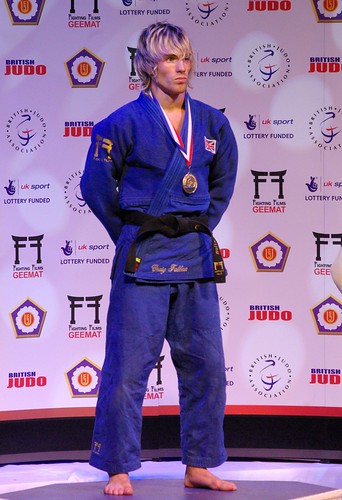
Recently a colleague of mine sent me a study he conducted some time back observing British fighter Craig Fallon in action at the 2003 European Championships. Dave Elmore analysed all the fights Craig had on the day against Paischer, Uematsu, Morokhovets, Nazaryan and Khergiani. He carefully recorded the time spent in the following categories:
- Adjusting Judo Gi
- Gripping
- Ne – Waza (grappling)
- Hajime
- Matte
- Attacking – Tachi – Waza
- Defending Tachi – Waza
Dave is the Judo Development officer at the University of Wolverhampton in the UK. He also runs the very good Advanced Apprenticeship Judo Blog. He looked at the data on a fight by fight basis and also overall, which produced the following chart:
As you can see from the chart, very little time was spent by Craig Fallon attacking in Tachi Waza. A majority of the matches was taken up with Ne Waza, Kumi Kata and adjusting Judo suits. Of the 19 minutes and 23 seconds spent in the competition, only 33 seconds of that time was actual attempts at throwing. Now there are lots of reasons for this, not least of all the speeed at which attacks happen. What stands out is the percentage of time that Craig spent fighting for a grip (29.41%), which shows the importance kumi kata perhaps.
31.30% of Craig Fallon’s time was spent in Ne Waza, it would be interesting to conduct a wider study looking at an entire category or event to see if this is a feature of Craig Fallon’s Judo or of light weight Judoka, or not.
The amount of time spent adjusting the Judo suits is also an eye opener, not an area of Judo that I have seen recorded before and as the chart shows quite a large part of the fight was spent just getting dressed (26.57%). Again this may be a feature of the fighting style of Craig and his opponents, it would be interesting to see if this amount of time is consistent across weights and genders.
If these numbers were to be proven to be standard across Judo, then it would have implications for coaching. Kumi Kata is growing in acceptance as an important skill that must be practised, this study supports this idea. This study could be used to justify increasing the amount of time drilling and practising kumi kata in club training sessions.
The amount of time spent adjusting the Judo Gi may also be important in terms of recovery time between segments of action during a match. Further study might provide suggestions to train for shorter bursts of action, or perhaps more grip related training similar to that shown on the Judo-Sport blog recently (via www.planetjudo.com).
Dave has kindly provided me with his data and I shall be looking at it in more detail and will post a follow up in a future article.

From someone who has studied more than my fair share of film on Craig Fallon I am here to tell you that he is one of the few 60kg players that spends that amount of time in newaza. This is the first time that I’ve actually seen someone do something close to what it is that I do to prepare my clients for competition. This only a part of the whole thing but this is impressive none the less. If you look at Fallon’s throw selection you will see that his time in newaza is influence by his throw selection and his throw selection is influenced because of his “finishing” rate in newaza.
Very good.
Kudos to you for a great analysis.
Rhadi Ferguson, PhD
Hi Rhadi,
I have been thinking of buying your scouting Product for a while now, I became a fan of yours after Brian Picolo spoke so passionately about you on thejudopodcast.com
The late Simon Hicks (of Fighting Films) got me interested in the analysis of players and the action. I have also been very fortunate to have been exposed to Sport Science at University of Bath, from where I know Dave Elmore who did this study.
I started this site to share and encourage data collection and analysis in Judo.
Thanks coming by and taking the time to comment, I really appreciate it.
Lance